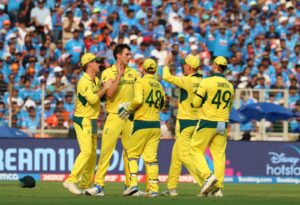
There was a hint of a Martin Crowe in Pat Cummins’ decision to throw in Glenn Maxwell to do battle with an aggressive Rohit Sharma inside the power play in the World Cup final in Ahmedabad on Sunday.
Think of it, there was a greater touch of a chess Grandmaster risking a piece to wrest control of the board than perhaps the late New Zealand captain, who employed Dipak Patel’s off-spin at the start of the innings in the 1992 World Cup.
In a match that lasted 93 overs, there will be many turning points and that each student of the game will pick one or the other as the one that had the most decisive impact on the outcome of the game. From the sluggish nature of the pitch that challenged India more than a better-prepared Australia to cricketing skills, from decision-making to fighting spirit, a lot will come up.
India’s decision to leave out R Ashwin and continue with Mohammed Siraj despite the track expected to play on the slower side could spring up in some discussions. The Indians made a tacit admission by getting Siraj to bowl the 17th over, rather than have him operate with the new ball as in all other games.
Cummins’ decision to invite India to bat first, too, would figure prominently in other conversations, especially with teams usually wanting to post a tall total and pile the pressure on the opposition. But with Rohit revealing at the toss that he would have liked to bat first in any case, there would not be much spice in that chat.
The cheap dismissals of Shubman Gill and Shreyas Iyer, two batters expected to take the mantle from Rohit and Virat Kohli as bulwarks of the Indian side going forward, would be talking points for some, while the inability of Kohli and KL Rahul to break free, as well as Australia’s bowling and fielding will engage many more.
That India played as many as 138 dot balls — equalling 23 overs — through its innings will not be lost on anyone. And the fact that India’s fourth-wicket pair put on 67 runs in 18.1 overs contrasted sharply with Australia’s fourth-wicket partnership between Travis Head and Marnus Labuschagne posting 192 runs in 35.5 overs would be another major talking point.
Rohit could have attacked a bit more when defending 240. The absence of close-in fielders when Ravindra Jadeja and Kuldeep Yadav were bowling allowed Australia to drive pressure away. Perhaps, the pitch was too slow for the spinners’ liking. Besides, Head and Labuschagne would have embraced a different approach when batting with a more attacking field.
For me, the psychological gamble that Cummins took in bringing on off-spinner Maxwell against Rohit will remain the single biggest turning point. Like through the tournament, the Indian skipper continued to impose himself on the new-ball bowlers and looked well on his way to a big score.
From the corner of his eyes, Maxwell saw Rohit commit himself on his front foot. And he dragged the ball short. The Indian captain skipped down the track and went ahead with his expansive shot. After all, he had sent the ball soaring high and long for six a couple of deliveries earlier and he was keen to make Australia pay for risking a second over of spin in power play.
Maxwell took the pace off the ball and landed it short enough to deny Rohit the pleasure of getting to the pitch of the ball. With the skipper intent on going through with the stroke, he miscued it over cover for Head to run back from point, stretch to his left and complete an outstanding catch.
The balance between passion and aggression on the one side with calmness and clarity of thought to make good decisions is an incredibly hard one to achieve. On Sunday, Rohit needed to bring in some ice to balance the fire that raged in his belly, but came up short and India finished with 240 rather than 280-plus or even 300 that could have challenged the Australians.
The disappointment in Rohit’s eyes was as evident as the boundless joy that Head and Maxwell showed in the moments after the decisive wicket was taken. But more than anything else, Cummins’ smile as he raced to envelop Head in an embrace was reflective of the impish delight that his gamble had paid off.
Deep down, even while he would have been aware that much work was left to be done before he could lay his hands on the World Cup, Cummins could draw immense satisfaction that his high risk decision to bowl Maxwell in the power play against a rampaging Rohit was among the biggest decisions impacting the outcome of the final.
Cummins the bowler also played a huge role in orchestrating the result of the final — finding the outside edge of Iyer’s bat with a short-pitched delivery and forcing Kohli to deflect another to his wicket, but it was his successful ploy against Rohit’s vanity that would have given him the most satisfaction.
His decision and, more importantly, persisting with it for a second over, gave him and his team a lot of clarity. Everyone around the Australian captain was more at ease once Rohit had been prized out. The hesitation and doubt that could have crippled the team’s progress in the final were dispensed off when his high-risk decision was rewarded.